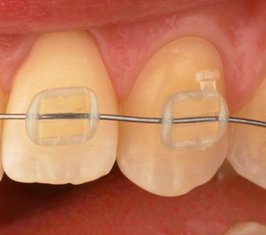Nanoparticles improve strength of 'invisible' dental brackets
8 November 2012
A polymer used for dental braces has improved mechanical properties and abrasion resistance when alumina nanoparticles are added to the ingredients, and so can better withstand the wear and tear of chewing.
Brackets made from clear plastic polymer used in dental correction orthodontics have produced very good results in recent years, especially in relation to the improved esthetics when compared to metal brackets, but they do present certain problems of wear and tear within the mouth.
The solution is to use very hard alumina nanoparticles and spread them evenly in the polysulfone, the polymer mould that is used in the industrial production of dental brackets.
This new process, patented by the Composite Group and Universidad Carlos III de Madrid (UC3M) researchers, has produced a new material which increases mechanical as well as friction resistance, thereby maintaining the brackets’ transparency. “We have been able to develop a more rigid material with this technology which has a clearly improved friction resistance, thus helping to withstand the wear and tear produced by the teeth or by chewing, explained Professor Juan Baselga, head of the UC3M Polymers and Composite Group. In addition, it is biocompatible, which is essential for something that is going to be used in the mouth, and complies with European requirements for products which are in contact with food.
These new types of materials- nano-reinforced plastics- have applications in diverse areas of industry, according to the researchers. In particular, polysulfone is of interest in the bio-health field because of its bio-compatibility in the development of medical- surgical equipment, where it is of the essence to improve rigidity and friction resistance. Furthermore, it has potential applications in the auto industry and in the area of safety such as, for example, the development of a new visor for firefighters.

Dental brackets made of the new polymer material
This innovation allows nanoparticles to be incorporated and evenly dispersed in a polymer mould in a very low proportion. After this process that is based on green chemical techniques is carried out by UC3M researchers, the particles, which are now dispersed in the polymer through micro-extrusion and micro-injection techniques, are then mixed to produce the final piece in the CEOSA-Euroortodoncia. “ We measure out the plastic since the minimum that a normal machine can inject is 15 grams, whereas our pieces weigh .06 grams…it would be akin to injecting insulin with a horse syringe”, explained the company director, Alberto Cervera. “And with the technology we are using, micro-extrusion and the micro-injection, we are capable of controlling these minuscule quantities of material with the utmost precision,” he added.
The relationship between UC3M and CEOSA/Euroortodoncia takes advantage of the synergy between the public and private sector. “We are a small to medium-sized enterprise and we get support from the University to produce a first rate product, which is then advantageous in the agreements which we have had for a decade in the form of end-of-degree-projects, doctorial theses and joint research programs within the European Union and in the Madrid Autonomous Community, for example,” Alberto Cervera ellaborated. “We learn a lot from this collaboration,” continued Juan Baselga, “because this company presented us with real problems that they face in their industrial area and they open up their laboratories to our needs.”